You might have the best, most beautiful sounding acoustic guitar but still get crappy recordings. Nothing is more frustrating.
No, the problem might not be your mic placement. You’ve probably already mastered how to record acoustic guitar, so don’t start questioning your engineering skills. And your recording space could be treated perfectly.
You see, the problem could simply be your microphone.
In an attempt to help you get the best recordings possible, we put together a list of the best microphones for recording acoustic guitar. If you don’t have one of the mics on this list, you should seriously consider getting one (or a comparable one).
It could make a world of difference in the quality of your recordings.
Audio-Technica AT2035
The AT2035’s forte is versatility and reliability. Yes, there might be crisper sounding mics out there, but this large-diaphragm condenser microphone will deliver a consistent, low self-noise sound every time.
Its cardioid pattern makes it great for acoustic guitar. And because of the 80Hz high-pass filter on the mic (which helps cut down on low, rumbling frequencies) it’s great for home studios.
It’s not for every instrument, but it’s perfect for recording acoustic guitar.
Specifications and features:
- Cardioid polar pattern
- Frequency response: 20Hz-20kHz
- Low-frequency roll-off: 80Hz, 12dB/octave
- Impedance: 120 ohms
- 10dB pad
- XLR output connector
- Requires +48V phantom power
Shure SM81
With the Shure SM81, you’ll be able to get a precise, clear sound on your acoustic guitar. Often used to record choirs or as an overhead drum mic, this small-diaphragm condenser mic also works great on acoustic guitar. Plus, it has a bass roll-off switch to help cut out some low end.
For DIY musicians on a budget, this mic is on the more expensive end, but it’s worth every penny.
Specifications and features:
- Cardioid pickup pattern
- Flat, 20-20,000Hz frequency response
- -10dB pad
- Low RF susceptibility
- Flat, 6/octave, or 18dB/octave rolloff
- Requires +48V phantom power
AKG Perception 170
AKG is a trusted name in the recording industry, and the P170 small-diaphragm condenser mic fits that reputation. It’s a versatile mic, working on anything from drums to, you guessed it, acoustic guitar.
The great thing about this mic is that you get quality for a very affordable price. You could even get two to mic your guitar for an enhanced stereo sound.
Specifications and features:
- 20dB preattenuation pad
- Cardioid polar pattern
- Frequency range: 20Hz-20kHz
- Requires +48V phantom power
Rode NT2A
Thanks to the Rode NT2A’s large diaphragm (one inch), multiple pickup patterns, high-pass filters, and pads, you have as much versatility as you’ll need for recording guitar.
As far as pickup patterns, you can choose from a Figure 8, Cardioid, or Omni, allowing to record more than just acoustic guitar if needed. On the front of the mic, you have switches for a 40Hz or 80Hz high-pass filter as well as a pad adjustment of 0dB, -5dB or -10dB attenuation.
Specifications and features:
- Three selectable polar patterns: Omni, Cardioid, Figure 8
- Three selectable high-pass filters: Flat, 80Hz or 40Hz
- Three selectable attenuation settings: 0dB, -5dB or -10dB
- Low noise
- Internal capsule shock mounting
- Requires +48V phantom power
Neumann TLM 103
The Neumann TLM 103 is a large-diaphragm condenser mic with transformerless circuitry and the classic Neumann sound we’ve all come to expect and respect.
Whether you’re a home studio producer or making music in the fanciest studios around, this mic should be in your arsenal. It’s got a wide dynamic range, so it works great in the studio or on the stage.
And because of the cardioid pattern, it will pick up mainly what’s in front of the mic, shushing surrounding sounds. The capsule is based on the capsule in U 67 and U 87 microphones — some of the best high-end mics on the market.
Oh, and why “TLM”? That stands for “transformerless microphone,” which means that instead of a transformer, there’s an electronic circuit.
Specifications and features:
- Large-diaphragm cardioid condenser microphone
- Pressure gradient transducer with one-diaphragm capsule
- Transformerless circuitry
- Very low self-noise
- Frequency range: 20Hz-20kHz
- Rated impedance: 50 ohms
- Requires +48V phantom power
Shure KSM44A
This mic will set you back a at least a whole paycheck, but there’s reason for that.
This large-diaphragm condenser mic allows you to select between a cardioid, omnidirectional, or figure-8 pickup pattern. You can also choose to turn on the high-pass filter.
Plus, it has an internal pop filter, cutting down on plosives. And Shure’s Prethos Advanced Preamplifier Technology helps keep down the noise. Its very wide frequency response means you can capture every bit of your guitar’s characteristics — from soft to loud, low to high.
Specifications and features:
- 4dB of self-noise
- Cardioid, omnidirectional, and figure-8 polar patterns available
- Wide frequency response (20Hz-20kHz)
- Switchable 15dB pad for handling extremely high sound-pressure levels (SPLs)
- Three options on the selectable low-frequency filter: -6dB/octave below, 115Hz, or -18dB/octave below 80Hz)
- Three layers of protection against plosives
- Requires +48V phantom power
What Mic Do You Use?
Again, the lack of quality in your acoustic guitar recordings could simply be a low-quality mic. Whether you use Pro Tools or GarageBand, a PC or a refurbished Macbook — the mic you use is super important.
Is your microphone on this list? If not, do you think it should be? Let us know why in the comments.



